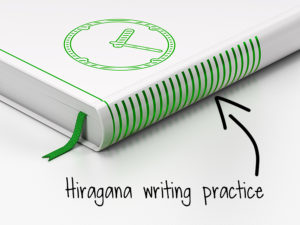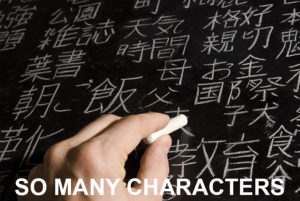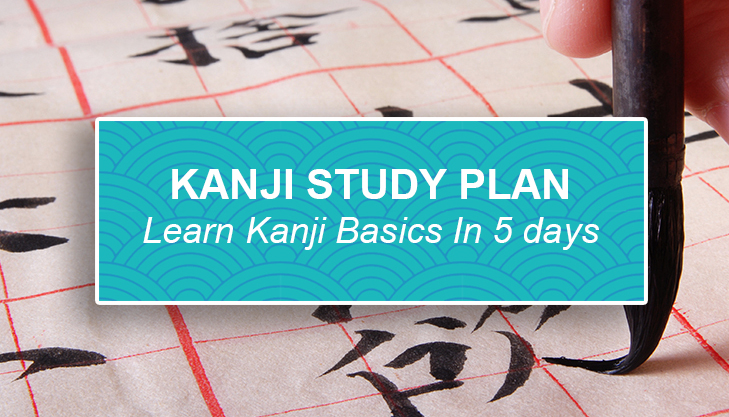If you’re at the beginning of your journey into the Japanese language, the first thing you’ll need is a hiragana self study routine! Hiragana is the first set of characters you will learn to begin reading Japanese and you can teach yourself in just a few days.
The key points to learning hiragana without a teacher are: good resources, good study routines and determination. The routine you set up now will either help or hinder your entire Japanese journey so I’ll show you how to get into good habits early.
Unless you’re still in education you probably don’t have a regular study routine currently. Self study has some major obstacles so it’s important to know what to focus on. You’re probably excited to get started, so let’s jump in.
Before you start the hiragana self study routine.



A good place to store your writing is in a notebook! Who would have thought?
There are a couple of things you need to think about to decide if self study is right for you. I’ll be writing a post on that soon but for now, I’ll assume you’ve thought it over and come to the conclusion that you would prefer to study alone!
Decide what your Japanese focus and goals are.
You can’t study effectively if you don’t know what you’re working towards. Hiragana is important to any form of Japanese reading so your overall goals won’t effect the plan too much in this routine but it’s still important to consider them so you can tailor your study plan. Later on you might decide that you have no interest in reading and concentrate only on listening and speaking. But if your aim is to read manga then you will definitely want to get as quick as possible at recognising characters.
Don’t get overwhelmed by jumping in too fast.
Timing is key to learning. Some people jump in head first and try to memorise every hiragana character in a day. Later they find they can’t recall anything well at all! Learning too much at once is just not effective. While it’s exciting to get started, if you commit to just doing a little bit every day and you will get much better results long term.
Set aside time every day.
The most important part of a study routine is constancy. A little bit every day is better than 1 long session once a week. Your brain will get fatigued with too much new information at once and not take any of it in. Personally I find that I learn best first thing in the morning so I do my study right after breakfast while I have a cup of coffee. Find what time learning works best for you. If you can, also get some music that you only listen to during study time so it sets the mood and primes your brain to learn.
This study plan aims for around 30 minutes a day but you can adjust that around your own learning speeds.
Consider your budget for resources.
If you don’t plan to go further than kana, you might want to splash out on the higher priced resources I recommend in this guide. If not then I recommend keeping your budget tight for hiragana and splurging further down the line when you start kanji.
Before you start studying hiragana you will need:
- An iPhone or Android to download learning apps
- Access to a printer and paper
- A pen
Now let’s get to the first day!
![]()
![]()
![]()
![]()
![]()
![]()
![]()
![]()
![]()
![]()
![]()
Hiragana Self Study Routine
![]()
![]()
![]()
![]()
![]()
![]()
![]()
![]()
![]()
![]()
![]()



If your desk looks like this then you probably aren’t getting much learning done.
Day 1 – Getting comfortable with vowels and sounds.
There are 46 characters in basic hiragana and it almost doubles when you add in modifiers. We’re going to learn the base 46 over the next 5 days then tackle the modified characters on days 6 and 7.
As it’s the first day we’re only going to deal with the 5 vowels so you can get a feel of how Japanese actually sounds.
Key study points:
Download your study resources.
In this guide I will be assuming that you are using the apps I’ve recommended in my hiragana app guide. Specifically I am recommending Hiragana Memory Hint and Kana School for this course but you can substitute any of the other apps so long as you have a “learning app” and a “revision app”. The learning app should have an easy way for you to learn eg. mnemonics and the revision app should have a fast paced multiple choice test where you can select which characters to include.
Go ahead and install those apps and then print out several hiragana practice sheets for later use.
Pronunciation
The most important thing to take away from today’s study session is how the vowels are pronounced. The vowel sounds effect how all of the other Japanese characters sound so they are important to get right. Listen to the guides in your apps and try to say them out loud. Make sure that you are matching the Japanese pronunciation rather than your native language.
Study time break down:
- Download your study apps – 5min
- Learn the 5 vowel characters (A, I, U, E, O) in your study app – 10min
- Study pronunciation of the characters and say them out loud – 10min
- Revise the characters in your revision app – 5min
![]()
![]()
![]()
![]()
![]()
![]()
![]()
![]()
![]()
![]()
![]()
Hiragana Self Study Routine Day 2 – K and S characters



Remember that just highlighting English text will not improve your hiragana knowledge.
Today is our second day learning, so the first thing we need to do is revise the characters we learned yesterday. You only know the 5 vowels so far, so it should just take a few minutes to do your revision at the beginning of the study session.
Key study points:
Revising from yesterday
Revision will become an important part of your study routine so it’s good to get in the habit now. Start each session directly revising what you covered the day before. It doesn’t have to be in depth, don’t spend ages re-reading, just skim over the characters/mnemonics and run a round of the multiple choice quiz.
Understanding the sound table
After learning the next group of characters you should spend a little time looking over the rest of the hiragana chart to understand how the vowels interact with the table to make sounds. You can find a nice hiragana chart print out which includes stroke order or here’s one which includes all of the modifiers.
Study time break down:
- Revise yesterday’s vowels – 5min
- Learn the K characters (Ka, Ki, Ku, Ke, Ko) and S characters (Sa, Shi, Su Se, So) in your study app – 15min
- Look over the hiragana table to understand how the character sounds interact – 5min
- Revise today’s characters in your revision app – 5min
![]()
![]()
![]()
![]()
![]()
![]()
![]()
![]()
![]()
![]()
![]()
Hiragana Self Study Routine Day 3 – T and N characters with writing practice



Karen wondered why it was taking her so long to learn today’s 10 characters and then she realised this was all a dream, she was studying French and her name was Anne.
You don’t want to get bogged down so today we’re going to break things up so it’s a bit more interesting. After you’ve done your revisions and learned your new characters you will start to give writing a try.
By the end of today’s session you will know 25 characters, you’re more than half way there!
Key study points:
Revision tips
Today’s first revision should include all of the characters you’ve learned so far. Don’t spend any extra time on this, just try to answer as many questions as you can. It’s not important to revise every single character every day, just get a general gauge of how you’re doing.
The T’s
Keep a sharp eye out for the sounds of the T characters, so far most of the sounds have followed the table with their vowels. Chi and Tsu are a little bit different so watch the pronunciation.
Writing
Today we’re going to give writing a try. You should have already printed out your hiragana practice sheets so grab them and start writing. These days with computers and phones, people don’t write much in their every day lives. It’s much less important than it used to be to have perfect writing. Rather than learning to writing fluently, our practice aims to give your brain another way to remember the hiragana. This is particularly effective for characters you’re having trouble remembering so start with those.
Try to match your stroke order with the examples given and see how fast you can produce the characters accurately. I find it helps a surprising amount to say the character out loud as you go too.
Study time break down:
- Revise characters – 5min
- Learn the 5 T characters (Ta, Chi, Tsu, Te, To) and 5 N characters (Na, Ni, Nu, Ne, No) in your study app – 15min
- Practice writing a few of the characters – 5min
- Revise today’s characters in your revision app – 5min
Hiragana Self Study Routine Day 4 – H and M characters and mini revisions



Janine started practicing her hiragana and before she knew it, she’d written the recipe for tomato soup.
Today we tackle the H and M characters and do some writing revisions of the previous lessons. You should be in a routine of learning every day now so you might find yourself not needing the full time to learn the characters. If this is the case, don’t linger, just switch over to writing practice early and add some more characters.
Key study points:
Mini revisions.
At this point it’s a great idea to start doing mini revisions throughout your day. Each set of mini revisions should only take you a few minutes so stick to 5-10 questions. The aim of these revisions is to begin to speed up your recognition. You want to get as fast as possible so you can read easily without sounding things out. Don’t worry about getting answers wrong, just go with your first feeling until it becomes instinct.
Study time break down:
- Revise characters – 5min
- Learn the 5 H characters (Ha, Hi, Fu, He, Ho) and 5 M characters (Ma, Mi, Mu Me, Mo) in your study app – 15min
- Practice writing a few characters you have trouble remembering – 5min
- Revise today’s characters in your revision app – 5min
![]()
![]()
![]()
![]()
![]()
![]()
![]()
![]()
![]()
![]()
![]()
Hiragana Self Study Routine Day 5 – Y, R, W, N characters
Today is your last day of the basic hiragana characters, well done! There is only one more full set of 5 along with a few stragglers.
Once you complete the lessons today you will know all of the basic hiragana, so get studying!!
Key study points:
Left over characters.
Today’s lesson only has 1 full character set while the others are fewer than the full sets. The W and N characters here are often used in special ways. For example, the N character always comes at the end of the word and sometimes it sounds a bit more like an M. The Wo character is used as a particle which you’ll learn about later when you study grammar. Make sure you listen carefully to the pronunciation of Wo too as that can be a bit tricky!
Study time break down:
- Revise characters – 5min
- Learn the 5 R characters (Ra, Ri, Ru, Re, Ro), the 3 Y characters (Ya, Yu, Yo), the 2 W characters (Wa, Wo), and the N character in your study app – 15min
- Practice writing a few of the characters – 5min
- Revise today’s characters in your revision app – 5min
![]()
![]()
![]()
![]()
![]()
![]()
![]()
![]()
![]()
![]()
![]()
Hiragana Self Study Routine Day 6 – Modifiers – Dakuten and Handakuten



Charlotte laughed and returned the books to the library as she realised that this entire course was based around apps! Goodbye book carrying back pain!
Along with the 46 regular hiragana, there are little modifiers you add to them to change the sound. For this lesson make sure you have a hiragana chart that includes modified characters.
Key study points:
Understanding modifiers – Dakuten
The first of the modifiers we will study today are called Dakuten. They look a bit like quotation marks and you add them to top right of the regular hiragana to change the sound. They are used on characters that start with K, S, T and H. The same basic sound concepts apply, they just change the consonants so K>G, S>Z, T>D and H>B.
Understanding modifiers – Hadakuten
The second kind of modifier we’re looking at today is Hadakuten, it looks like a little circle and it’s used to change H sounds to P
Study time break down:
- Revise characters – 5min
- Learn the 5 kinds of modified characters that use Dakuten and Hadakuten – 15min
- Revise today’s characters in your revision app – 5min
Hiragana Self Study Routine Day 7 – Modifiers – Diagraphs



If hiragana feels like a lot of characters, don’t stress… just wait until you get to kanji!
You made it to the last day!!
Today we’re looking at a different kind of modifier: diagraphs. This kind is a mini hiragana character that’s put after the main character that changes the sound. If you’re using a standard flash card app these lessons may not be included and it may not appear in your revisions. Most apps focus on learning the standard hiragana and throw these in somewhere afterwards.
Key study points:
Understanding modifiers – Diagraphs Ya/Yu/Yo
Diagraphs are a kind of mini hiragana that’s put after the main character. It changes the vowel sound on the end, so for example Ki+mini ya = Kya sound. You can do this with Ya, Yu or Yo, just refer to your hiragana chart to see which characters it works with.
Understanding modifiers – Diagraphs Tsu
The tsu character is a little different. When Tsu is used as the mini character, it means that the next character’s consonant is double long. So Ki-mini tsu-Ko becomes ki-kko when you pronounce it.
Study time break down:
- Revise characters – 5min
- Learn the Y and Tsu modified characters in your study app – 15min
- Practice writing a few of the characters – 5min
- Revise today’s characters in your revision app – 5min
![]()
![]()
![]()
![]()
![]()
![]()
![]()
![]()
![]()
![]()
![]()
Congratulations you learned hiragana all on your own!



Congratulations on finishing hiragana! Go celebrate with your equally attractive friends! I need to buy some new stock images…
Well done on making it through your first week of Japanese study! You have successfully learned all of the basics you need for hiragana yourself. That deserves a big pat on the back!
Of course, this just a crash course so there are some other rules around hiragana but those will be covered in more depth when you start your grammar studies.
Now what? How do I apply this? Katakana?
Self study requires a lot of motivation and keeping up your routine is the best way to do that. Keep studying for 30 minutes every day and move on to the next challenge. If you need to take a break from learning new information, do a few days where you just revise your hiragana before moving on. Whatever you do, don’t break your routine or it will be harder to keep up your motivation!
Start trying to put your hiragana knowledge to use by reading anything you can. You won’t have the vocabulary to understand fully yet but the focus should be on character recognition.
Now you have completed your hiragana studies, get ready to start katakana. Katakana will require different techniques and routines so I will have a guide on that coming up next.
Keep studying!! Don’t stop doing mini revisions throughout the day, keep trying to improve your recognition speed.




